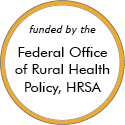Arkansas Models and Innovations
These stories feature model programs and successful rural projects that can serve as a source of ideas. Some of the projects or programs may no longer be active. Read about the criteria and evidence-base for programs included.
Evidence-Based Examples
UAMS IDHI High-Risk Pregnancy Program
Updated/reviewed March 2025
- Need: Arkansas had high rates of low birthweight babies, and pregnant patients in rural areas had difficulty accessing specialty obstetric care.
- Intervention: The University of Arkansas for Medical Sciences (UAMS) created the Institute for Digital Health & Innovation (IDHI) High-Risk Pregnancy Program to increase access to care for pregnant patients in an effort to improve outcomes for high-risk pregnancies.
- Results: The program has increased access to care and improved neonatal outcomes for rural Arkansas individuals through a variety of programs and has been recognized by various organizations as a model program.
Promising Examples
Arkansas Rural Health Partnership Hospital-based Transitional Care Program

Added July 2024
- Need: Solutions for Medicare beneficiaries' post-acute care recovery gaps in Arkansas's southeast Delta Region.
- Intervention: Supported by federal funding and their membership organization, seven hospitals implemented an evidence-supported Critical Access Hospital transitional care model.
- Results: Participating hospitals found a significant increase in swing bed services revenue, an all-cause low readmission rate, high percentage of patients discharged to home or to an assisted living environment, and positive patient satisfaction surveys.
Healthy Connections, Inc. Healthy Families Arkansas

Updated/reviewed December 2022
- Need: High poverty rates and lack of access to healthcare make caring for unborn and newborn children difficult for young mothers in Arkansas's Polk and Garland Counties.
- Intervention: An Arkansas-based program provides a national healthcare service to expectant and young mothers. Prenatal check-ups, education, transportation, well-baby checks and child immunizations are all provided by the Healthy Connections, Inc.
- Results: The program's results demonstrate an increase in first trimester prenatal care rates and child immunization rates, as well as a dramatic decrease in confirmed cases of child abuse.
Last Reviewed: 2/23/2024

